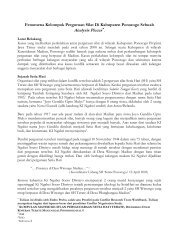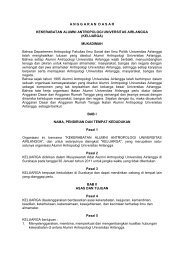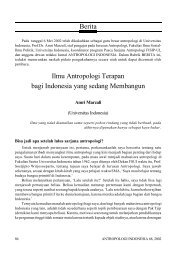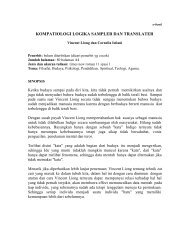The Future of Visual Anthropology: Engaging the Senses
The Future of Visual Anthropology: Engaging the Senses
The Future of Visual Anthropology: Engaging the Senses
Create successful ePaper yourself
Turn your PDF publications into a flip-book with our unique Google optimized e-Paper software.
widijanto judono e-Library collection - widijanto.wordpress.com<br />
<strong>Engaging</strong> <strong>the</strong> visual 9<br />
contradicted racist ideas about <strong>the</strong> impact <strong>of</strong> immigration in <strong>the</strong> USA (van Willigen<br />
2002: 24). A number <strong>of</strong> applied research organisations, such as <strong>the</strong> ‘Applied <strong>Anthropology</strong><br />
Unit in <strong>the</strong> Office <strong>of</strong> Indian Affairs’, were established and, for example,<br />
anthropologists were employed by <strong>the</strong> US Department <strong>of</strong> Agriculture. This culminated<br />
in anthropologists working ‘in support <strong>of</strong> <strong>the</strong> war effort during <strong>the</strong> 1940s’ and<br />
<strong>the</strong> establishment <strong>of</strong> <strong>the</strong> Society for Applied <strong>Anthropology</strong> (which still exists at <strong>the</strong><br />
beginning <strong>of</strong> <strong>the</strong> twenty-first century) and its related publications (van Willigen<br />
2002: 26–8). Although applied anthropology was accepted and more strongly established<br />
in <strong>the</strong> USA than in Britain it still remained a contested practice.<br />
By <strong>the</strong> 1950s anthropology had experimented with and rejected <strong>the</strong> senses,<br />
visual methods and technologies, and applied practice. <strong>The</strong> social and cultural<br />
mainstream was establishing itself as a scientific <strong>the</strong>oretical discipline, distinguished<br />
from o<strong>the</strong>rs by its emphasis on long-term fieldwork, its relativism and<br />
comparative project.<br />
From <strong>the</strong> 1940s to 1980s: a marginalised presence<br />
Taking <strong>the</strong> development <strong>of</strong> scientific anthropology that rejected <strong>the</strong> visual, sensory<br />
and applied as context, I now focus on <strong>the</strong> advances that were made in <strong>the</strong>se areas<br />
in <strong>the</strong> mid-twentieth century. After Malinowski and Boas photography and film<br />
were not entirely absent from <strong>the</strong> anthropological endeavour. For example, Evans-<br />
Pritchard’s Nuer publications (see chapter 2), <strong>the</strong> electronic archive <strong>of</strong> Paul<br />
Stirling’s Turkish village research, including photographs from 1949–51 fieldwork,<br />
16 and Julian Pitt-Rivers’ 1950s fieldwork in Sou<strong>the</strong>rn Spain (Pitt-Rivers<br />
1963). Ethnographic photography from this period was usually used as illustration<br />
ra<strong>the</strong>r than being conceived as an analytical or methodological tool and is now<br />
interpreted as an objectifying practice. 17 It was thus unchallenging to <strong>the</strong> contemporary<br />
anthropological project. A more ambitious project was Bateson and Mead’s<br />
photography and film in Bali, coupled with Mead’s conviction that visual anthropology<br />
could serve a scientific, objective anthropology (discussed in detail in<br />
chapter 2). This work, moreover, attended to sensory experience; Jürgen Streek<br />
notes Bateson and Mead’s stress on Balinese ‘cultivation <strong>of</strong> <strong>the</strong> tactile aspect <strong>of</strong><br />
actions, i.e. <strong>the</strong> very subtle application <strong>of</strong> pressure by <strong>the</strong> finger-tips to <strong>the</strong><br />
malleable substance <strong>of</strong> meat’, and how, combining image and word to represent<br />
this, ‘Bateson and Mead wrote <strong>of</strong> “emphasis on <strong>the</strong> separateness <strong>of</strong> <strong>the</strong> fingers and<br />
on <strong>the</strong> sensory function <strong>of</strong> <strong>the</strong>ir tips” (Bateson & Mead, 1942: 100)’, also shown in<br />
<strong>the</strong>ir photography. 18 Both <strong>the</strong> successes and failures <strong>of</strong> Bateson and Mead’s Bali<br />
photography and cine-film are interesting. <strong>The</strong>ir success was in publishing an innovative<br />
and important landmark text in anthropology, which continues to be influential.<br />
However, this project failed to achieve its potential to persuade<br />
anthropologists <strong>of</strong> <strong>the</strong> time <strong>of</strong> <strong>the</strong> value <strong>of</strong> systematic visual research and analysis as<br />
a contribution to <strong>the</strong> scientific anthropology <strong>of</strong> <strong>the</strong> era (Morphy and Banks 1997:<br />
10–11; see also Grimshaw 2001: 88 and Ginsburg 2003) or inspire an anthropological<br />
focus on <strong>the</strong> senses. 19










